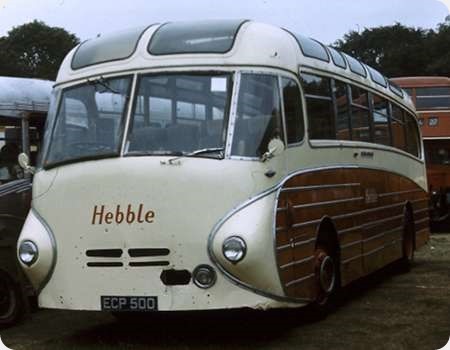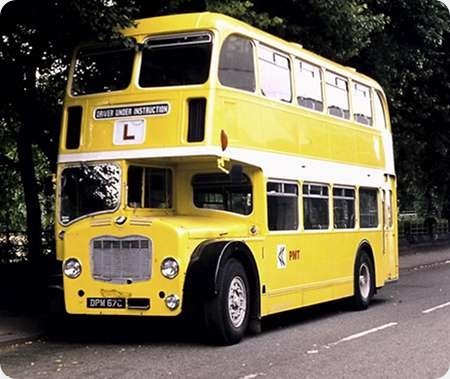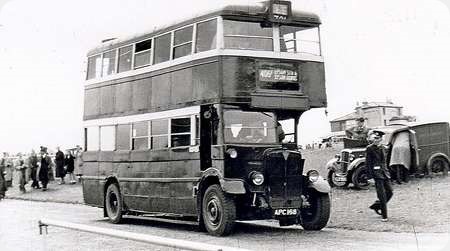Hebble – Leyland PSU1/16 – ECP 500 – 74
Hebble Motor Services
1954
Leyland PSU1/15
Bellhouse-Hartwell C37C
This amazing creation was photographed at the Rotherham rally in August 1976. I wonder what has happened to it since. There are photos on flick-r showing it undergoing heavy restoration but no further details. It would be great to see it out and about again. Makes you wonder how it survived until 1976.
Photograph and Copy contributed by Ian Wild
27/04/20 – 07:31
Ian,
There is plenty about these if you go onto MDS book sales website and download (its free to do so) the book – 12 Royal Tigers – Its basically the history of Bellhouse Hartwell and Beccols vis-a-vis the battle with Blue Cars, that brought about the demise of the latter.
Its a great read and heartily recommended!
Mike Norris
27/04/20 – 11:23
….. and the last two Bellhouse Hartwell Landmasters ever were a pair of MU3RV Reliances for SUT. They came between about 22 Duple Elizabethan Reliances and the first of SUT’s 30 Burlingham Seagull Reliances.
David Oldfield
27/04/20 – 12:55
Sadly Ian, you won’t be seeing it out again.
ECP 500 had passed to Frank Cowley (dealer), Salford in 12/66 and then to Talbot House Special School, Glossop who had a wheelchair lift fitted into the rear, but fortunately set into the existing rear dome. It lost its chrome bumpers, Royal Tiger badge and ornate Standard Vanguard Phase II front grille but otherwise remained fairly original.
It passed to John Hinchcliffe of Huddersfield in the mid-1970’s for intended preservation, at which time I was told by him that the bodywork was extremely sound. However with a lot of work to do on it and other projects in hand he decided to sell it to a preservation group based at Liversedge, who I’m told loaned it to another group with YWD connections, and whose apprentices were supposed to be restoring it and it did appear at a number of rallies in the condition depicted in Ian’s photo. This project appears to have failed and it then passed through a variety of would-be preservationists in Lancashire, until it eventually ended up in a serious state of deterioration exposed to the elements. It was advertised for sale in about 2001 and it is said that despite its extremely parlous condition Ensign acquired it as a major restoration project, but that even they had to admit defeat as it was just too far gone. Sadly it was scrapped. One of the more regrettable losses to the preservation movement.
John Stringer
27/04/20 – 12:57
The company began in the 1800s as the dye works Bellhouse Higson which became incorporated as a limited liability company on 10 July 1914 and changed its name when A.W. Hartwell joined in around 1932. For much of its later existence the company specialised in subcontracting to the aircraft industry, but entered the psv bodying business in the post WW2 boom period. Initially bodying conventional front engined chassis, the firm is best remembered for its flamboyant styling of bodywork for underfloor engined chassis from 1951, of which the Hebble coach is an example, which possibly suggested inspiration derived from the spaceships in the Dan Dare comic strip. As David states above, the last psv bodies were delivered in July 1955, after which the firm reverted to concentrating on aerospace industry work. In 1964 the business was sold to the Hampson Jig Tool company, and it finally closed its doors on 13 November 2002. The first link below gives a potted history of the firm in the Bolton News, which differs in minor detail from James Taylor’s account in his A-Z Of British Bus Bodies. The second link illustrates a splendid array of various Bellhouse Hartwell bodies.
www.theboltonnews.co.uk/news/ – www.busphoto.co.uk/gallery.php
Here is a later, rather sad picture of this coach. www.flickr.com/photos/
Roger Cox
28/04/20 – 06:25
John – sad to hear that it has been scrapped. Such an unusual coach.
Ian Wild
30/04/20 – 06:06
I had the privilege of travelling on this or a sister beast from Burnley to Blackpool at a date I would estimate as being around 1964. Certainly, it was after the new Burnley Bus Station came into use. This was a journey that I made with my parents at intervals during the year, having relatives living in Blackpool. As a 12-ish year-old, I had an interest in buses, and from experience expected that we would end up a on a Ribble operated J1 or J2 duplicate, probably an already elderly Royal Tiger with Leyland or Burlingham bodywork, or maybe even one of their less-appreciated Tiger Cubs with later Seagull bodies. In the past I had seen Ribble half-cab coaches duplicating these services and had always hoped one would show up for me, but it never happened!
I think that I had seen these Hebble vehicles once or twice previously in Burnley Bus Station and been fascinated by their already dated but exotic appearance, so different from anything that Ribble or other familiar operators ran. So, imagine the excitement when this beauty pulled into the stand, and we were allowed to board! I remember being able to bag the seat right behind the driver, so close that there was basically nothing between my seat and the panel of lights and switches to his right. To my mind that ride was a major “cop” that I still remember 55 or more years on!
I have wondered since which service this would have been on. The most frequent Yorkshire – Blackpool routes (of the ones that passed through Burnley) were the J1 and J2 via Keighley and Colne, but these seemed exclusively Ribble or West Yorkshire operated, though I suppose that Hebble could have provided a duplicate from Leeds or Bradford. I was aware from timetable leaflets of other J services that took the route through Halifax and Todmorden, and that might have been a more logical route for a Hebble vehicle to appear on. However, I very rarely spotted workings of these services on local roads and believe that they were seasonal and/or weekend operations (which may well have applied to the journey I described).
Ricky
15/01/21 – 11:38
I have only just found this page & it’s with great sadness I read about ECP 500’s demise. As a child in the 70s this bus was kept in the National bus garage in Liversedge where my uncle worked. Both my uncles & my dad all became members of the preservation group. My dad drove it on a number of rallies around Yorkshire, in fact he was probably the driver when this picture was taken as we lived near Rotherham at the time. Many happy memories of that time. So sad to hear its gone
Andy Stirling
Quick links to the - Comments Page - Contact Page - Home Page



